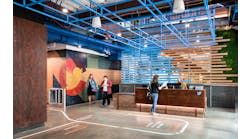If you have a warehouse, meeting space or supermarket in your portfolio, you’re probably aware of the cost and complexity of high bay lighting applications. Finding the right fit for these spaces is a challenge, but the long life and low maintenance needs of LED lighting may be a good match for your facility. Ensure a successful LED retrofit with these tips.
1) Specify the same base configuration
Before you start weighing any other product specifications, make sure you’re only looking at lamps with the same base (such as metal halide base E39 or incandescent base E26 medium), as well as the same aesthetic effect, the Department of Energy recommends. This will ensure that your new LED lamps produce roughly the same amount of light while consuming less energy.
2) Consider control strategies
LEDs dim easily and work well with lighting control systems, which can be very useful in tricky lighting situations where a couple of light switches won’t cut it. Dillon Gymnasium, which houses NCAA wrestling and volleyball matches at Princeton University and also serves as a base for the campus recreation program, received a 111-fixture lighting retrofit with a sophisticated control system in 2012.
“We ended up working with the manufacturer to create a custom interface,” notes William Evans, Electrical Engineer for Princeton University. “We initially reduced energy consumption from 256W down to 180W for each fixture, but once we installed the control system, we were able to reduce it again by 80% during recreational times due to the occupancy sensors we employed throughout the gym.”
3) Know your usage patterns
Understand where and how each space uses lighting to find additional opportunities for your LED lighting to save money. One project, a retrofit at a 1 million-square-foot Ace Hardware distribution facility in Rocklin, CA, was projected to save roughly 50% on energy just from upgrading to LED from metal halide. The owner hoped to save an additional 50% on the lighting control system for a total savings of 75% but needed to fine-tune the control strategies first.
The lighting control system was eventually configured to enable several strategies. The facility started with task tuning, then progressed to occupancy control with coarse zoning and daylight compensation. Data from the occupancy sensors in each luminaire was analyzed and showed the team that not all of the stock areas were accessed with the same frequency, which could facilitate additional savings. The owners revised their lighting strategies to include fine zones, some of which only included one fixture. The end result: energy savings averaging 81% over the 1,500 T5 fluorescent and 100 metal halide fixtures previously installed in the facility.


